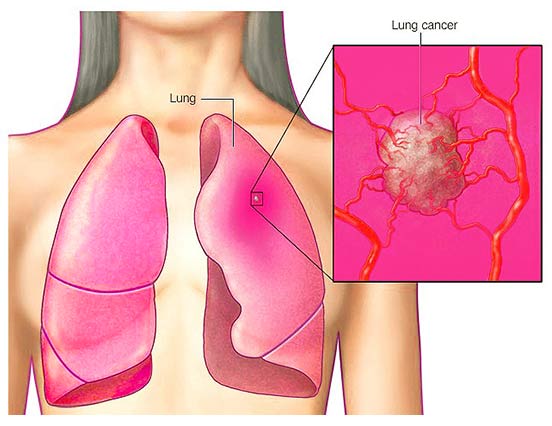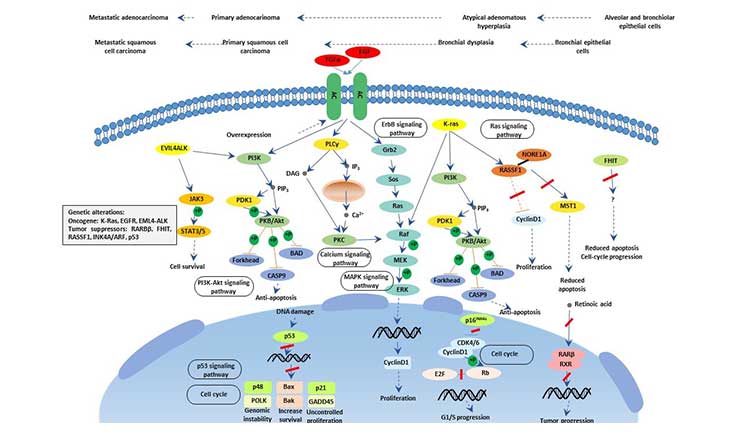[1] De Marco C, Laudanna C, et al. Specific gene expression signatures induced by the multiple oncogenic alterations that occur within the PTEN/PI3K/AKT pathway in lung cancer [J]. PLoS One.2017, 12(6).
[2] Fan J, Bao Y, et al. Mechanism of modulation through PI3K-AKT pathway about Nepeta cataria L.'s extract in non-small cell lung cancer [J]. Oncotarget. 2017, 8(19):31395-31405.
[3] Jin X, Luan H, et al. Netrin‑1 interference potentiates epithelial‑to‑mesenchymal transition through the PI3K/AKT pathway under the hypoxic microenvironment conditions of non‑small cell lung cancer [J]. Int J Oncol.2019, 54(4):1457-1465.
[4] Pikor LA, Lockwood WW, et al. YEATS4 is a novel oncogene amplified in non-small cell lung cancer that regulates the p53 pathway [J]. Cancer Res.2013, 73(24):7301-12.
[5] Sun Y, Cao L, et al. WDR79 promotes the proliferation of non-small cell lung cancer cells via USP7-mediated regulation of the Mdm2-p53 pathway [J]. Cell Death Dis. 2017, 8(4):e2743.
[6] Xing Y, Liu Y, et al. TNFAIP8 promotes the proliferation and cisplatin chemoresistance of non-small cell lung cancer through MDM2/p53 pathway [J]. Cell Commun Signal. 2018, 16(1):43.
[7] Okimoto RA, Lin L, et al. Preclinical efficacy of a RAF inhibitor that evades paradoxical MAPK pathway activation in protein kinase BRAF-mutant lung cancer [J]. Proc Natl Acad Sci U S A. 2016, 113(47):13456-13461.
[8] Bhardwaj V, Mandal AKA. Next-Generation Sequencing Reveals the Role of Epigallocatechin-3-Gallate in Regulating Putative Novel and Known microRNAs Which Target the MAPK Pathway in Non-Small-Cell Lung Cancer A549 Cells [J]. Molecules. 2019, Jan, 24, 2.
[9] Wagner AH, Devarakonda S, et al. Recurrent WNT pathway alterations are frequent in relapsed small cell lung cancer [J]. Nat Commun. 2018, Sep 17;9(1):3787.
[10]Luca Lignitto, Sarah E LeBoeuf, Harrison Homer, et al. Nrf2 Activation Promotes Lung Cancer Metastasis By Inhibiting The Degradation of Bach1[J], CELL, 2019.
[11]Akbar Khanmohammadi, Ali Aghaie, Ensieh Vahedi, et al., Electrochemical Biosensors For The Detection Of Lung Cancer Biomarkers: A Review[J]. TALANTA, 2019.
[12]Roberto Ruiz-Cordero, Walter Patrick Devine, Targeted Therapy And Checkpoint Immunotherapy In Lung Cancer[J], SURGICAL PATHOLOGY CLINICS, 2020.
[13]Keisuke Asakura, Tsukasa Kadota, Juntaro Matsuzaki, et al. A MiRNA-based Diagnostic Model Predicts Resectable Lung Cancer in Humans with High Accuracy[J], COMMUNICATIONS BIOLOGY, 2020.
[14]Iakovos Toumazis, Mehrad Bastani, Summer S Han, Sylvia K Plevritis, Risk-Based Lung Cancer Screening: A Systematic Review[J], LUNG CANCER, 2020.
[15]Frank M Sullivan, Frances S Mair, William Anderson, et al. Earlier Diagnosis of Lung Cancer in A Randomised Trial of An Autoantibody Blood Test Followed By Imaging[J], THE EUROPEAN RESPIRATORY JOURNAL, 2021.
[16]Yue Zhao, Yuxia Liu, Shuang Li, Zhaoyun Peng,et al. Role of Lung and Gut Microbiota on Lung Cancer Pathogenesis[J], JOURNAL OF CANCER RESEARCH AND CLINICAL ONCOLOGY, 2021.
[17]Pranavi Koppula, Guang Lei, Yilei Zhang, et al. A Targetable CoQ-FSP1 Axis Drives Ferroptosis- and Radiation-resistance in KEAP1 Inactive Lung Cancers[J], NATURE COMMUNICATIONS, 2022.






Comments
Leave a Comment